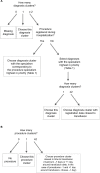Why was this transfusion given? Identifying clinical indications for blood transfusion in health care data
- PMID: 29636633
- PMCID: PMC5881526
- DOI: 10.2147/CLEP.S147142
Why was this transfusion given? Identifying clinical indications for blood transfusion in health care data
Abstract
Background: To enhance the utility of transfusion data for research, ideally every transfusion should be linked to a primary clinical indication. In electronic patient records, many diagnostic and procedural codes are registered, but unfortunately, it is usually not specified which one is the reason for transfusion. Therefore, a method is needed to determine the most likely indication for transfusion in an automated way.
Study design and methods: An algorithm to identify the most likely transfusion indication was developed and evaluated against a gold standard based on the review of medical records for 234 cases by 2 experts. In a second step, information on misclassification was used to fine-tune the initial algorithm. The adapted algorithm predicts, out of all data available, the most likely indication for transfusion using information on medical specialism, surgical procedures, and diagnosis and procedure dates relative to the transfusion date.
Results: The adapted algorithm was able to predict 74.4% of indications in the sample correctly (extrapolated to the full data set 75.5%). A kappa score, which corrects for the number of options to choose from, was found of 0.63. This indicates that the algorithm performs substantially better than chance level.
Conclusion: It is possible to use an automated algorithm to predict the indication for transfusion in terms of procedures and/or diagnoses. Before implementation of the algorithm in other data sets, the obtained results should be externally validated in an independent hospital data set.
Keywords: electronic health record data; indication for transfusion; selection algorithm.
Conflict of interest statement
Disclosure The authors report no conflicts of interest in this work.
Figures
Similar articles
-
Optimizing research in symptomatic uterine fibroids with development of a computable phenotype for use with electronic health records.Am J Obstet Gynecol. 2018 Jun;218(6):610.e1-610.e7. doi: 10.1016/j.ajog.2018.02.002. Epub 2018 Feb 9. Am J Obstet Gynecol. 2018. PMID: 29432754 Free PMC article.
-
Validation of an electronic coding algorithm to identify the primary indication of orthopedic surgeries from administrative data.BMC Med Inform Decis Mak. 2020 Aug 12;20(1):187. doi: 10.1186/s12911-020-01175-1. BMC Med Inform Decis Mak. 2020. PMID: 32787849 Free PMC article.
-
A rule-based electronic phenotyping algorithm for detecting clinically relevant cardiovascular disease cases.BMC Res Notes. 2017 Jul 14;10(1):281. doi: 10.1186/s13104-017-2600-2. BMC Res Notes. 2017. PMID: 28705240 Free PMC article.
-
Improving automated case finding for ectopic pregnancy using a classification algorithm.Hum Reprod. 2011 Nov;26(11):3163-8. doi: 10.1093/humrep/der299. Epub 2011 Sep 12. Hum Reprod. 2011. PMID: 21911435 Free PMC article.
-
Novel Method to Flag Cardiac Implantable Device Infections by Integrating Text Mining With Structured Data in the Veterans Health Administration's Electronic Medical Record.JAMA Netw Open. 2020 Sep 1;3(9):e2012264. doi: 10.1001/jamanetworkopen.2020.12264. JAMA Netw Open. 2020. PMID: 32955571 Free PMC article.
Cited by
-
Electronic health records reveal variations in the use of blood units by hour and medical specialty.Vox Sang. 2025 Jun;120(6):584-596. doi: 10.1111/vox.70016. Epub 2025 Apr 23. Vox Sang. 2025. PMID: 40268495 Free PMC article.
References
-
- Biggin K, Warner P, Prescott R, McClelland B. A review of methods used in comprehensive, descriptive studies that relate red blood cell transfusion to clinical data. Transfusion. 2010;50(3):711–718. - PubMed
-
- Tinegate H, Chattree S, Iqbal A, et al. Ten-year pattern of red blood cell use in the North of England. Transfusion. 2013;53(3):483–489. - PubMed
-
- Bruun MT, Pendry K, Georgsen J, et al. Patient blood management in Europe: surveys on top indications for red blood cell use and Patient Blood Management organization and activities in seven European university hospitals. Vox Sang. 2016;111(4):391–398. - PubMed
-
- Frank SM, Resar LM, Rothschild JA, Dackiw EA, Savage WJ, Ness PM. A novel method of data analysis for utilization of red blood cell transfusion. Transfusion. 2013;53(12):3052–3059. - PubMed
LinkOut - more resources
Full Text Sources
Other Literature Sources



